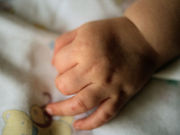Even if they are put to sleep on their backs, they often end up in parents’ bed, other unsafe positions
MONDAY, Aug. 15, 2016 (HealthDay News) — Despite decades of warnings from the “Back to Sleep” campaign, many parents are still putting their infants to sleep in ways that raise the risk of sudden infant death syndrome, according to research published online Aug. 15 in Pediatrics.
The study included 160 families who agreed to have video equipment set up in the room where their infants slept. Recordings were taken on three nights — when babies were 1 month, 3 months, and 6 months of age.
Overall, 21 percent of 1-month-olds were put to sleep on a surface that’s not considered safe — including their parents’ bed, a car seat, or baby swing. And 91 percent slept with unsafe items, such as pillows, stuffed animals, bumper pads, and sleep positioners. And while 86 percent of 1-month-olds were put to sleep on their backs, that shifted as time went on: At the age of 6 months, one-third of babies were placed in nonsupine position. It was common for infants — especially 1-month-olds — to be moved during the night, with increased likelihood of bed-sharing and nonsupine position at the second location at each time point.
Whatever the reasons for the study findings, senior researcher Ian Paul, M.D., a professor of pediatrics at the Penn State College of Medicine in Hershey, told HealthDay that it’s “clear” that safe-sleep messages are not working well enough. He said pediatricians and parents should keep talking about the topic during routine check-ups throughout infancy — and not just the newborn period.
Full Text
Copyright © 2016 HealthDay. All rights reserved.








